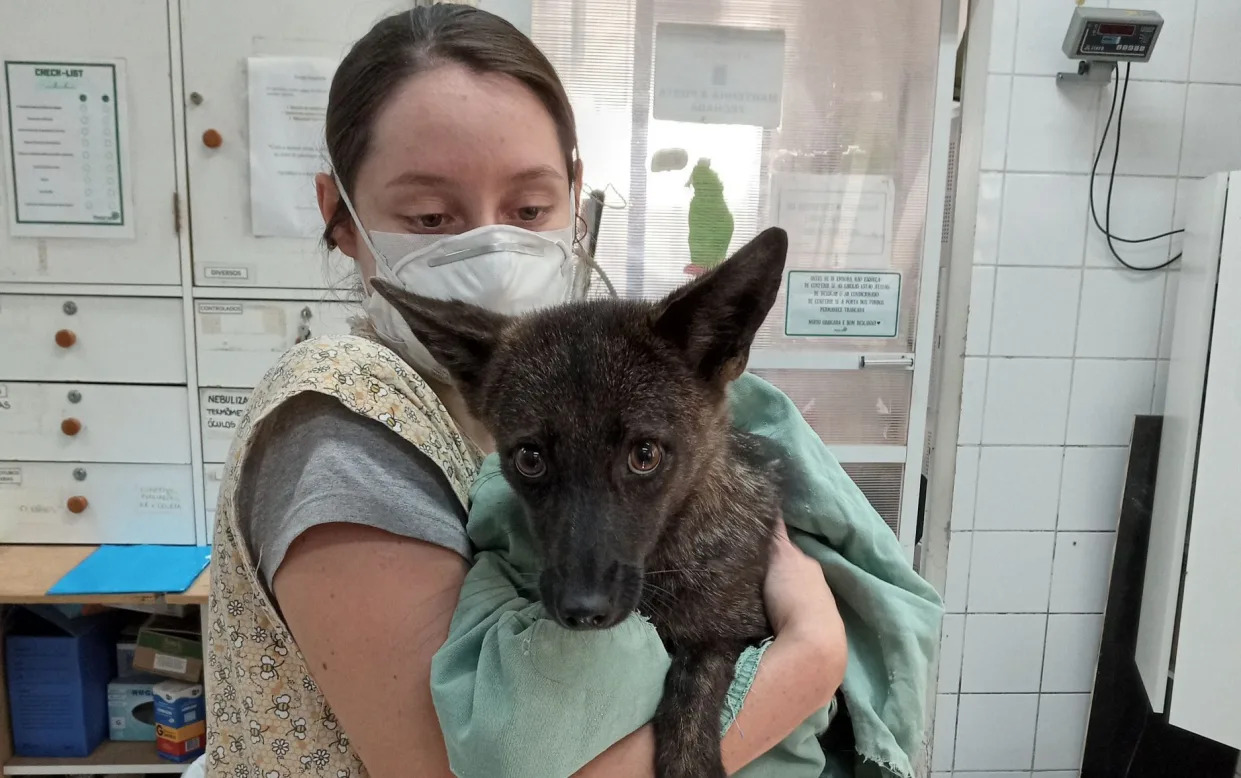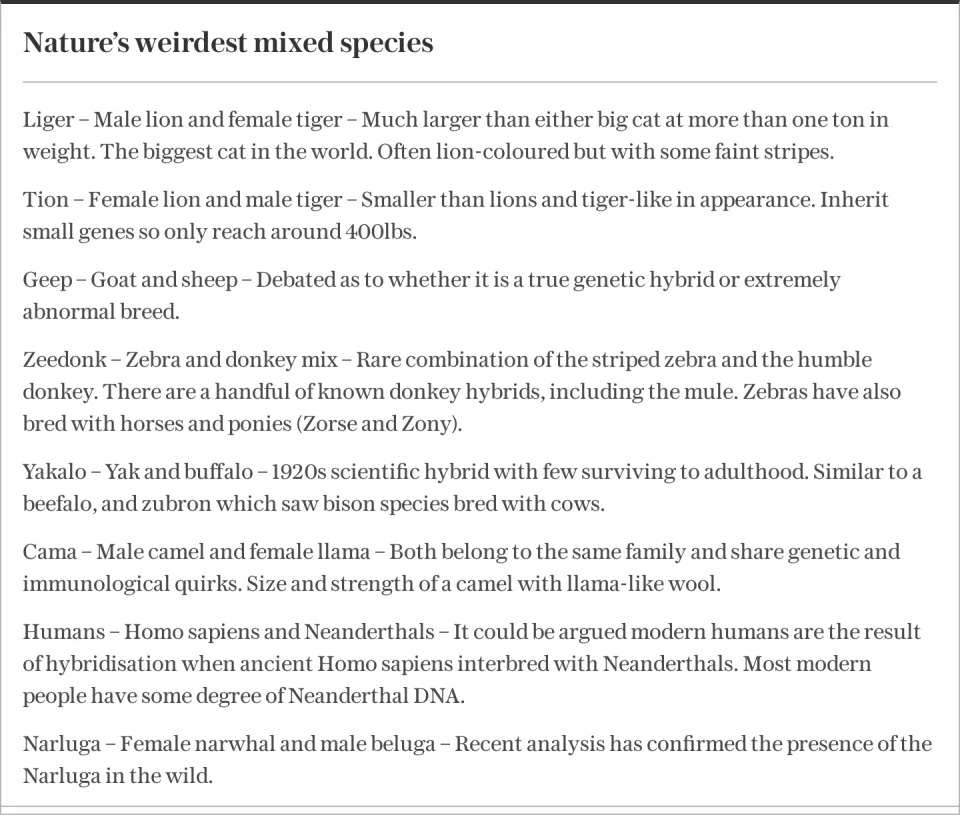Joe Pinkstone
Wed, September 13, 2023

Dog-fox hybrid dubbed 'dogxim' had a 'shy and cautious personality' - Flavia Ferrari
The world’s first confirmed dog-fox hybrid has been found in the Brazilian wilderness.
The animal was hit by a car in the area of Vacaria in 2021 and taken to a veterinary hospital for treatment but staff were unable to conclude whether it was a fox or dog they were taking care of.
Unusual physical characteristics, including some dog-like and some fox-like traits, piqued the interest of scientists from local universities who subsequently analysed her genes.
A recently published study revealed the animal’s mother was a pampas fox and her father a domestic dog of an unknown breed. It is the first recorded instance of a fox and dog breeding, experts believe.
It has the same build as a medium-sized dog, large, pointy ears, a long snout with a jet black nose and bulging brown eyes set into a thick, wiry black-brown coat with specks of white and grey throughout.

The animal has the same build and features as a medium-sized dog
The young wild canid was given the names “graxorra” and “dogxim” by carers and researchers.
The first moniker is a portmanteau of “grax”, from graxaim-do-campo, the Portuguese common name for the pampas fox, and “orra” from “cachorra”, which means female dog in Portuguese.
Academics also dubbed the animal “dogxim” as a merger of “dog” and “xim” from graxaim-do-campo.
The dogxim looked like both dog and fox, and also behaved in a strange way akin to both, the team noted. It refused food and ate live rodents; barked like a dog but had a thick, dark coat similar to the fox; and was wary of people but warmed to them over time.
“She was an amazing animal, really a hybrid between a pampas fox and a dog,” Flávia Ferrari, a conservationist that worked with the animal during her recovery, told The Telegraph.
“It was not as docile as a dog, but it also lacked the aggressiveness expected of a wild canid when handled.
“She had a shy and cautious personality, generally preferring to stay away from people. Over the time she was hospitalised for treatment, I believe she started to feel safer.”
Despite its fear of humans, the dogxim over time allowed some to approach if they were cautious and calm, Ms Ferrari said.
“So, in some moments, she allowed herself to be touched and even caressed, also interacting, and sometimes even playing with toys,” she added.
The animal was neutered as part of her treatment so scientists do not know if she would have been able to reproduce, but believe it would have been possible.
Scientists looked at the dogxim’s genes and found 76 chromosomes. Only one canid, the maned wolf, has this amount of chromosomes and it looks so different to the newly-discovered Brazilian animal that the scientists ruled it out.
A dog has 78 chromosomes and a pampas fox 74 and hybridisation of the two would produce 76 chromosomes. No other interspecies could produce the dogxim’s karyotype, the team says.
Mitochondrial DNA, which is passed down maternally in the cell’s energy-making capsules, revealed fox heritage. However, elsewhere in the genome were clear stretches of dog-like DNA.
“In our study we recorded the first case of hybridisation between one species of wild canid and the domestic dog,” study first author Bruna Elenara Szynwelski, a PhD student in genetics and molecular biology at Universidade Federal do Rio Grande do Sul, told The Telegraph.
“But, different to cases of hybridisation studied in North America, Europe, and Africa, this hybridisation occurred between species from the distinct genera: lycalopex and canis.”

Scientists found the animal to have 76 chromosomes - Flavia Ferrari
Dr Rafael Kretschmer, a cytogeneticist who ran the genetic analysis, said: “She is not a new species; she is a hybrid individual between two different species: pampas fox and domestic dog.
“We consider her to be unique because it was the first case of hybridisation between pampas fox and domestic dog and the first case of hybridisation between dogs and wild canids in South America.”
The animal was cared for at the veterinary hospital of the Universidade Federal do Rio Grande do Sul, where she recovered fully and was then transferred to a conservation centre called Mantenedouro São Braz in Santa Maria city.
The movement of the rare animal was organised by the region’s government. She died this year of unknown causes.
Hybrids have been seen before of domestic dogs and other wild species including coyotes, wolves and dingos.

Nature’s weirdest mixed species
However, these instances involved interspecific breeding of animals in the same genus (canis). South American foxes, however, belong to the genus lycalopex.
Lycalopex animals, which includes the pampas fox, are genetically different to both dogs and European foxes. The genus name literally means “wolf fox”. This hybrid is believed to be the first time a dog has bred outside the canis group.
“Although the common English name is pampas fox, the species is not closely related to the European foxes,” Dr Kretschmer said.
“The pampas fox is more closely related to dogs. Even so, this hybridisation occurred between two species that are more phylogenetically distant than the previously reported hybridisation reported in other parts of the world.”
Further investigations required
The team published their findings in the journal Animals and believe there may be more dogxims in the wild, with this individual being the tip of the iceberg and the only one to be captured and studied.
“Our findings suggest that this individual represents a first-generation hybrid between a dog and a pampas fox,” the scientists write in their paper.
“This discovery implies that, although these species diverged about 6.7 million years ago and belong to different genera, they might still produce viable hybrids. Further investigations are required to determine the fertility of these hybrids.”
Human activity has pushed the pampas fox into closer contact with people, and therefore dogs, and increased the likelihood of these species mating, the team say.
It remains unknown how common the hybridisation event occurs but the overlap of foxes and dogs increases the chance of them meeting and mating.
The team published their findings in the journal Animals and believe there may be more dogxims in the wild, with this individual being the tip of the iceberg and the only one to be captured and studied.
“Our findings suggest that this individual represents a first-generation hybrid between a dog and a pampas fox,” the scientists write in their paper.
“This discovery implies that, although these species diverged about 6.7 million years ago and belong to different genera, they might still produce viable hybrids. Further investigations are required to determine the fertility of these hybrids.”
Human activity has pushed the pampas fox into closer contact with people, and therefore dogs, and increased the likelihood of these species mating, the team say.
It remains unknown how common the hybridisation event occurs but the overlap of foxes and dogs increases the chance of them meeting and mating.
No comments:
Post a Comment